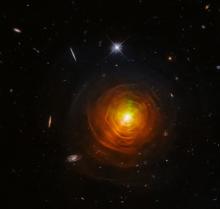Listen to today's episode of StarDate on the web the same day it airs in high-quality streaming audio without any extra ads or announcements. Choose a $8 one-month pass, or listen every day for a year for just $30.
You are here
Crimson Star
One of the reddest stars in the galaxy bounds across the south on February evenings. It’s in the “fur” of Lepus, the rabbit. The star’s main name is R Leporis. But it’s better known as Hind’s Crimson Star, after the astronomer who discovered it, in the 19th century.
The star looks so red for a couple of reasons. And both of them are related to its age.
Hind’s Crimson Star is in the final stages of life, so its outer layers have puffed up to giant proportions — about 75 times the diameter of the Sun. That’s made the surface of the star cooler, so it shines an orangey red.
At the same time, a lot of carbon has been dredged from inside the star and pulled to the surface. The carbon absorbs blue light, enhancing the red.
Some of the carbon, along with other elements, is being blown into space by a strong “wind” from the star. The wind is much thicker than the wind from the Sun. And it’s a first step in the star’s demise. Eventually, the star’s outer layers will all blow out into space, forming a beautiful bubble. Over tens of thousands of years, the bubble will spread out and vanish from sight. After that, only the star’s hot core will remain — a tiny stellar corpse known as a white dwarf.
Lepus is in the south as night falls, below Rigel, the bright blue-white star that marks the foot of Orion the hunter. Hind’s Crimson Star is too faint to see with the eye alone. But a small telescope reveals its rich color — the color of a dying star.
Script by Damond Benningfield





